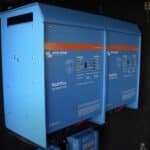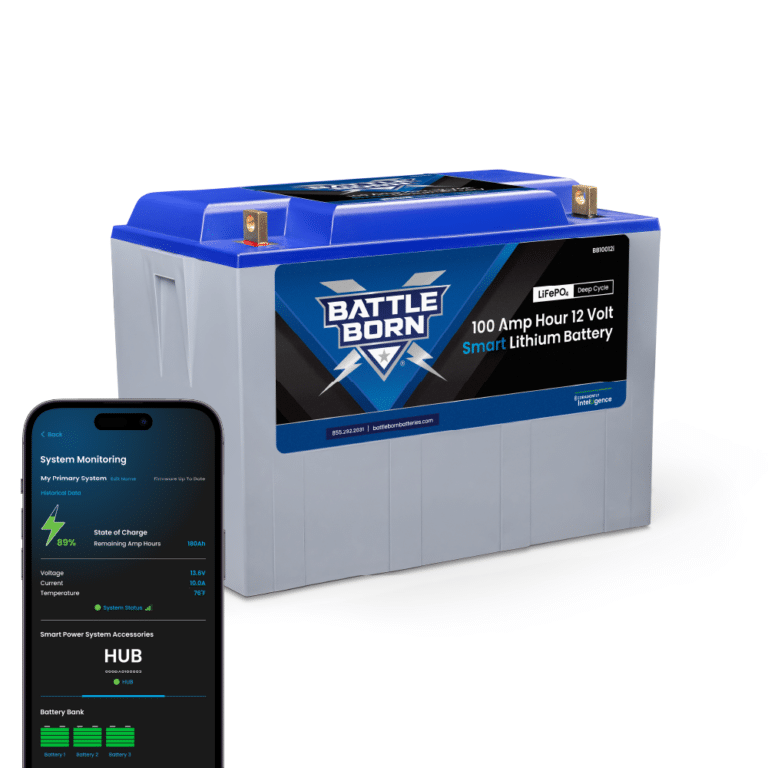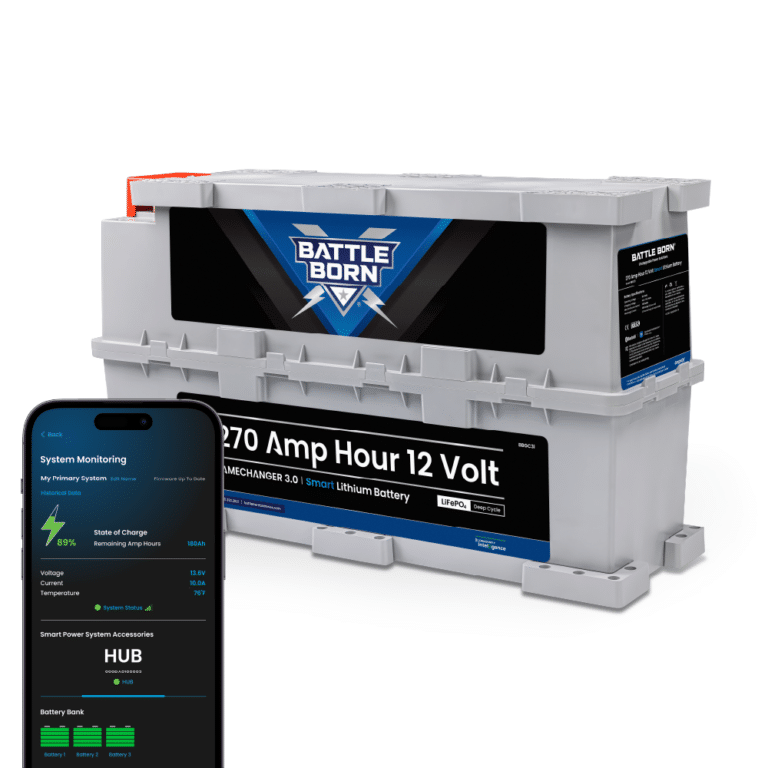
MENUMENU
TALK TO AN EXPERT
Special Hours: 7AM – 6PM PST
TALK TO AN EXPERT
Special Hours: 7AM – 6PM PST
While 12-volt batteries are most used in RVs, there are a variety of amp-hour sizes and larger voltage options for those who want power for longer periods of time or for larger loads. It can be overwhelming trying to determine what size battery you need. We’ll dive into basic battery sizes, how they equate to Battle-Born Batteries, and what you need to do to determine the size of battery you need for your RV.
Following the Industrial Revolution, electronic devices have become ubiquitous, easing their way into nearly every part of our daily lives. From the time our alarm clocks wake us up in the morning to the computers we use in the office or at school and even the televisions we turn on when we return home in the evening, our days revolve around electronics. As technology continues to progress, even the ways we transport ourselves from one place to another are becoming electric.
Since electronics rely on electrical currents to function, there are two basic ways that they can be powered. Initially, electronics were plugged directly into the electrical current that came from the electrical grid or other sources. While this limits the locations where these devices can be used and leaves them tied to a cord, they have minimal power limitations. As long as the grid has power or another source has fuel, your plugged-in electronics will simply continue to function.
In recent decades, the use of battery-powered electronic devices has become the norm. The inherent need to use electronic devices on the go and untethered from a cord or the grid led to the creation of the battery. Batteries are “devices that convert the chemical energy contained within their active materials directly into electric energy by means of an electrochemical oxidation-reduction (redox) reaction. This type of reaction involves the transfer of electrons from one material to another via an electric circuit.”
Although all batteries perform the same overall function, they are not all created equal. Batteries can either be rechargeable, through the electrical grid, or disposable and simply replaced when they lose their ability to create electric energy. Depending on what they are powering, batteries will vary in size and chemical composition.

The size of a battery is generally related to the amount of power an electronic device requires. While tiny button cells can power wristwatches and small toys, remotes and flashlights require AA batteries as they are slightly larger. Additionally, the length of time you would like the battery to power your electronic will also factor into its size. Even though smoke detectors aren’t much larger than many other electronics that take C and D batteries, they require a 9-volt battery as their ability to have power for long periods of time is crucial.
When it comes to your RV, 12-volt deep cycle house batteries are typically used to keep all of your electronics up and running. These batteries tend to be significantly heavier and larger than a typical household battery. This is because these batteries provide power for multiple electronics, light switches, and outlets rather than just one electronic device. Also, while a TV remote will only need power in very short bursts, RV batteries power some electronics, such as air conditioners and refrigerators, that require power for hours at a time.
While 12-volt batteries are mostly used in RVs, there are a variety of amp hour sizes as well as larger voltage options for those who want power for longer periods of time or for larger loads. It can be overwhelming trying to determine what size battery you need. First and foremost, we recommend taking inventory of the space you have in your RV for batteries. Although we would all love unlimited power, RVs generally have limited storage areas and strict weight requirements that will influence your decision. Once you know your maximum capacity, you can investigate various battery sizes and form factors. Then, you can choose the one with maximum power potential that meets your space constraints.
To create standardization among rechargeable batteries used in RVs, boats, and cars, the Battery Council International (BCI) defined specific group sizes for batteries based on their size and other features. “BCI Group Sizes are issued to identify the correct battery for automotive applications. Batteries are classified into numbered group sizes according to their voltage, maximum overall dimensions, terminal arrangement, and special features that may affect battery fit.”
When it comes to deep cycle house batteries found in RVs, there are four group sizes that are most used based on space requirements and power capabilities.
Group 24 batteries are typically standard model lead-acid batteries with these dimensions: 10.5″L x 6.1875″W x 8.875″H. They are commonly used “in vehicles, backup power systems, and medical systems.” While they can be used as a starting battery, they are frequently used as a deep-cycle house battery in RVs and similar systems.
Group 27 batteries are also a standard-model lead-acid battery. Their dimensions measure 12.5″ L x 6.75″ W x 9.37″ H. These batteries are the most common type of deep-cycle battery “used for automotive, marine, off-the-grid, RVs, and similar applications.” Additionally, these batteries have a larger group number, which indicates a higher number of amp-hours than a Group 24 battery.
Group 31 batteries come in a variety of chemistries, including “Flooded Lead Acid Batteries (FLA), Absorbent Glass Mat Batteries (AGM), Gel types, and LiFePO4 options.” Their dimensions measure 13” L x 6.8” W x 9.44” H. Since these batteries are only slightly longer and wider than Group 27 batteries, they can often be used interchangeably in a variety of marine, RV, commercial trucks, golf carts, and off-grid power systems.
Group 8D are some of the largest 12-volt lead-acid batteries available. Their dimensions generally measure 21” L x 11” W x 10” H. Nearly double the size of Group 24 batteries, these batteries are much heavier but also offer nearly twice the power, making them perfect for off-grid and marine applications.
While group sizes were initially created for lead acid batteries, many lithium batteries have adopted the size characteristics of their lead acid counterparts. Although they take up the same physical space, these LiFePO4 batteries offer 2-3x the power, are 1/5 of the weight, and have a 10x longer lifespan. Since you’ve already determined the space constraints for your batteries, lets look at the dimensions of Battle Born Batteries and group size comparisons.
The last step before purchasing your RV batteries is to determine the right voltage and number of amp hours for your system.
Whether you need a 12V or 24V battery will depend directly on your RV. Most RVs generally require 12V batteries, meaning that under a nominal load, the battery will supply 12V. However, some RV systems require more power, and in this case, they would need a 24V battery to meet the nominal load of 24V.
Additionally, you can create systems with larger voltages for RVs with high power loads by wiring batteries together in series. Running batteries in series means they have a single electrical path equal to the sum of the system’s volts. So, if you have two 12V batteries wired in series, then your system is 24V. Up to four Battle Born Batteries can be wired together in series to create up to 48V power systems.
Finally, you will need to determine the number of amp hours your system requires depending on what you want to power. This will directly determine how many batteries you need based on which battery type you choose for your space constraints. You can do this by conducting an electrical audit that determines your electronics’ energy usage through manual calculation or using a battery monitor. Then, you can simply enter this information into the Battle Born Battery Calculator, and it will tell you how many amp-hours of batteries your system requires.
*IMPORTANT: We strongly recommend you DO NOT attempt to mix battery sizes (amp-hours) and connect them together. Due to differences in battery management systems and battery cell counts, there may be a charging and voltage discrepancy between batteries.
We know that building or upgrading an electrical system can be overwhelming, so we’re here to help. Our Reno, Nevada-based sales and customer service team is standing by at (855) 292-2831 to answer your questions!
Also, join us on Facebook, Instagram, and YouTube to learn more about how lithium battery systems can power your lifestyle, see how others have built their systems, and gain the confidence to get out there and stay out there.
Shop Best Sellers








Ask a technical specialist now at 855.292.2831
Stay in the Know